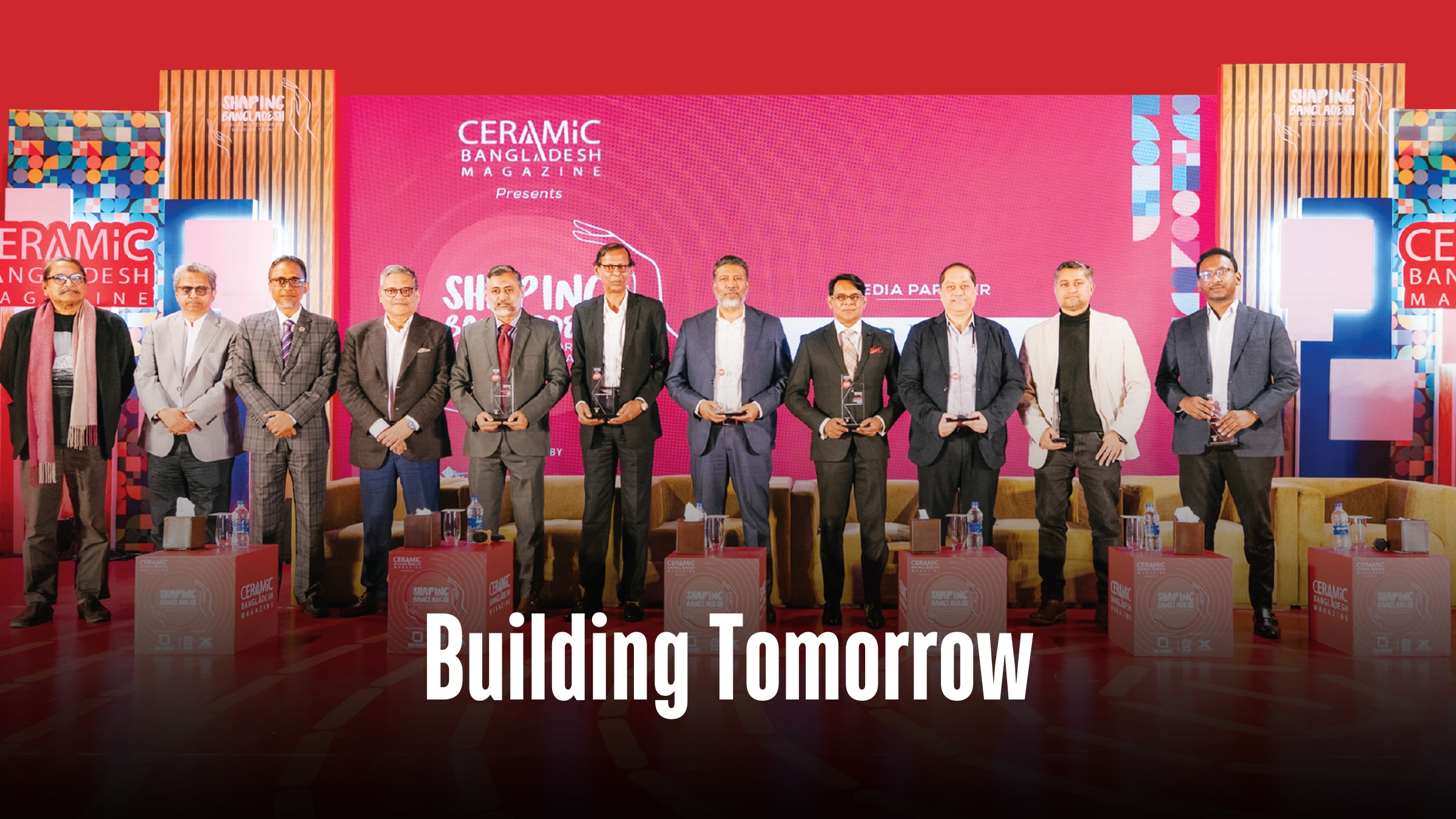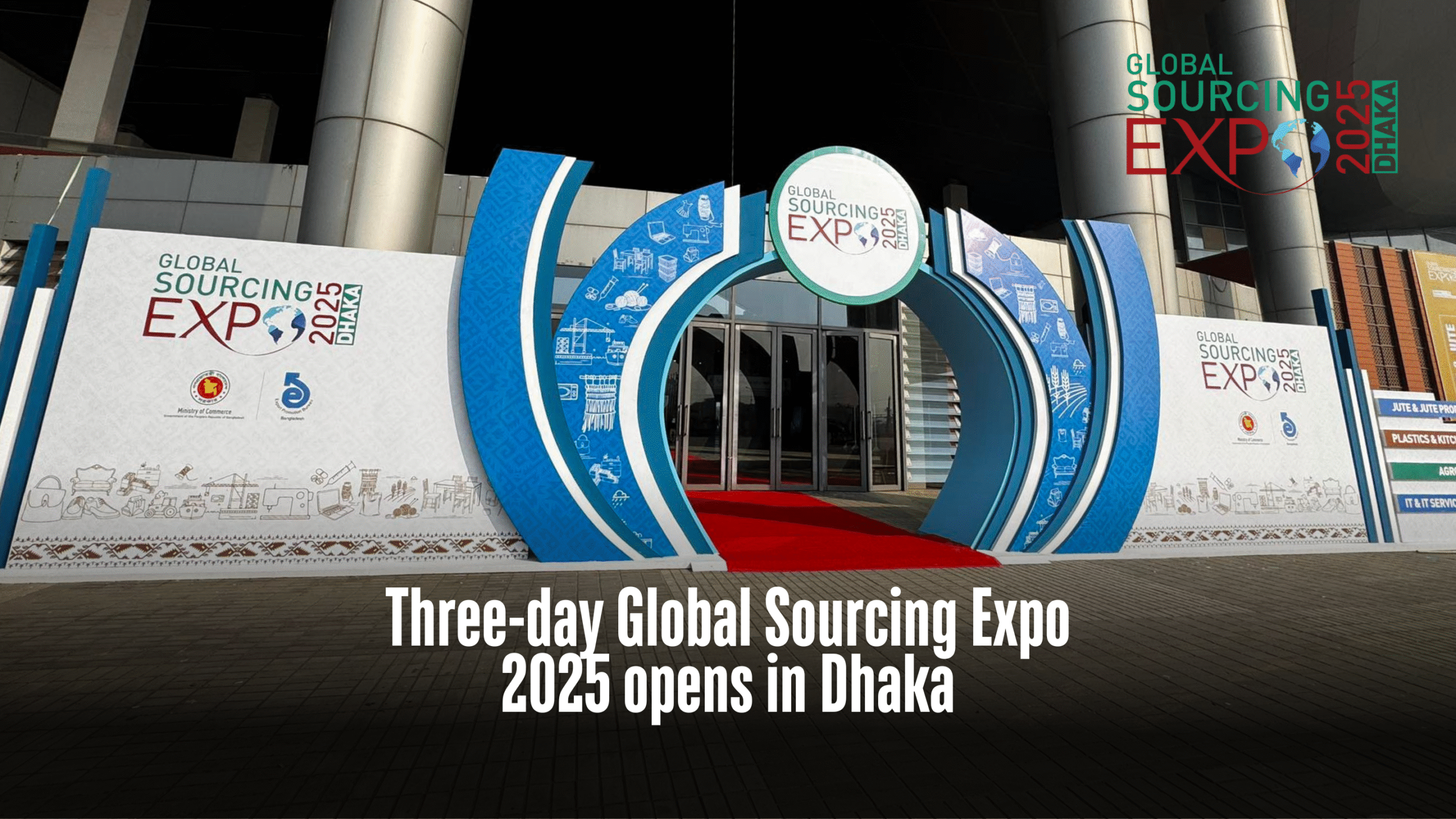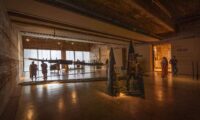
Industry Leaders Unite for a Greener Bangladesh
A Call for Sustainable Transformation On January 30, 2025, the Sheraton Hotel in Dhaka hosted “Shaping Bangladesh: Designing Tomorrow, Building Today”, a landmark event organised by Ceramic Bangladesh Magazine. It brought together leaders from construction, real estate, and ceramics to champion sustainability and innovation in response to environmental challenges. Thought Leadership for a Greener Future As part of the series “Innovating for a Sustainable Future II”, the multi-panel format featured experts from ceramics, cement, and real estate. Moderated by Dr. Amir Ahmed of Daffodil International University, the panels included Muhammad Badrul Hassan (BBS Cables), Salehin Musfique Sadaf (GPH Ispat), Architect Faysal Ahmed (Concord Real Estate), AKM Ziaul Islam (Magna Ceramic), Mohammad Khorshed Alam (Akij Bashir Group), Asadul Haque Sufyani (Metro Cement), and Babor Hossain (Khadim Ceramics). Key Recommendations for Sustainability Panelists urged greater investment in R&D to reduce reliance on imports and foster local innovation. They called for collaboration across sectors to promote recycled materials and eco-friendly components. Suggestions included using fly ash and slag in cement, adopting hybrid or electric furnaces, and implementing energy-efficient manufacturing. Smart Materials and Policy Reform Experts advocated for smart glass technologies—low-E, solar, and self-cleaning—to boost building efficiency. They also recommended policy reforms to protect local manufacturers from zero-tariff imports and emphasized the need for government-run clay mines to secure raw materials for ceramic production. Bangladesh’s Tile Industry Comes of Age AKM Ziaul Islam highlighted the tile industry’s evolution since 1984. “We started with 100 mm tiles in one color. Now, we export to the USA,” he said. Despite high production costs, innovation has improved working conditions and sustainability, making the industry globally competitive. Real Estate and Domestic Innovation Architect Faysal Ahmed reflected on the sector’s overreliance on imports between 2000 and 2015. He stressed the importance of collaboration among architects, engineers, and academics to develop sustainable materials locally and reduce dependency on foreign technologies. Material Optimization for Environmental Impact Salehin Musfique Sadaf emphasized that optimized material use can reduce emissions and speed up construction. “Using 15,000 kg of cement instead of 20,000 kg without compromising strength means real sustainability,” he explained. Rethinking Cement and Energy Asadul Haque Sufyani discussed the carbon footprint of cement production and promoted fly ash and slag as eco-friendly alternatives. He stressed the need for affordable, sustainable materials and energy-efficient technologies. Energy Crisis and the Future of Glass Mohammad Khorshed Alam raised concerns about gas shortages affecting glass furnaces. He urged investment in hybrid furnaces and advanced technologies and called on architects to incorporate more locally produced glass to avoid overcapacity and unsold stock. Ceramic Bricks: A Smarter, Greener Choice Babor Hossain showcased ceramic bricks’ advantages over handmade red bricks—lower water absorption, higher strength, and reduced structural load. “They were used in national landmarks and can cut construction costs by 13 percent,” he said, advocating for government-run clay mines to sustain innovation. A Unified Path Forward The event concluded with a call for synergy among policymakers, industry, and academia. With rising climate risks and infrastructure demands, embracing innovation is not just strategic—it’s essential. Photo: Courtesy

Brac University launches design competition to reimagine community spaces
Brac University’s Department of Architecture, in collaboration with Elite Paint Bangladesh Limited, has announced a student design competition titled Architecture for Unity: Redesigning Community Spaces. The initiative invites architecture students to reimagine public spaces as inclusive environments that celebrate cultural diversity and foster meaningful interaction. The competition is exclusive to students enrolled in Brac University’s Department of Architecture and aims to empower future architects to design with empathy, inclusivity, and sustainability at the forefront. Designing for Diversity and Dialogue According to the official brief, participants are tasked with redesigning a community space—either real or hypothetical—that encourages cross-cultural engagement. The goal is to transform such spaces into vibrant hubs where people from different backgrounds can connect, collaborate, and celebrate shared humanity. The design criteria are both ambitious and socially grounded. Proposals must reflect the cultural richness of the community they serve, integrating elements that honour various traditions while promoting inclusivity. Spatial flow is a key consideration, with layouts expected to guide visitors through the space in ways that encourage movement and exchange. Functional diversity is also central to the brief. The redesigned spaces should accommodate a range of activities—from social gatherings and collaborative projects to quiet reflection—allowing individuals to engage in meaningful ways. Aesthetic appeal, while not the sole focus, remains important. Organisers are looking for innovative architectural techniques and visual storytelling that inspire curiosity and wonder. Sustainability is a non-negotiable component. Students must embrace environmentally responsible design principles that minimise ecological impact, including thoughtful choices in materials, lighting, and energy use. Submission Requirements and Format Participants must submit a comprehensive design proposal that includes conceptual sketches, spatial layouts, and explanatory notes. The drawing submission must be formatted as one A0 portrait sheet in PDF, with a resolution of 300 dpi and a maximum file size of 15 MB. In addition to the visual material, students are required to submit a text document—also in PDF format—describing the idea behind the project, its inspiration, tentative outcomes, and materiality. The written component must not exceed 500 words. All submissions must be in English. File names should follow a strict format: Student’s Name_Student’s ID_Enrolled Semester (e.g., Akibur Rahman_16208023_Fall 2023). Both the drawing and the text document must be uploaded via the designated online submission link before the deadline. Key Dates and Deadlines Registration Deadline: September 1, 2025 Submission Date: October 11, 2025 (by 5.00pm) Jury Date: October 26, 2025 Results Announcement: November 10, 2025 Students can register via the official link: https://forms.gle/ecZtUpRBmVo1jC7M7 Final submissions must be uploaded to: https://forms.gle/z5zhNK88uvH5ncU49 Awards and Recognition The competition offers substantial incentives. The first prize winner will receive BDT 50,000 and a certificate. The second and third place winners will be awarded BDT 25,000 and BDT 15,000 respectively, along with certificates. However, organisers stress that the real reward lies in the opportunity to contribute to a broader conversation about architecture’s role in social cohesion. “This is an ideas competition,” said a faculty member from Brac University’s Department of Architecture. “We’re not asking students to build anything physically. Instead, we want them to think critically and creatively about how architecture can serve as a tool for unity.” Industry Collaboration and Real-World Impact Elite Paint Bangladesh Limited’s involvement adds a layer of industry relevance to the competition. Known for its commitment to sustainable and community-focused projects, the company’s collaboration with Brac University signals a shared vision for inclusive urban development. “This is not just about buildings or parks,” said a spokesperson from Elite Paint. “It’s about creating spaces where people from different backgrounds can come together, share experiences, and build a sense of unity. We believe architecture has the power to shape social behaviour, and this competition is a step towards that vision.” Student Response and Anticipation As the submission window opens, anticipation is building across the Brac University campus. For many students, this competition represents a chance to showcase their design philosophy, engage with pressing social issues, and contribute to a vision of Bangladesh where public spaces reflect the country’s rich cultural mosaic. “We often talk about unity in abstract terms,” said one third-year architecture student. “This competition challenges us to make it tangible—to design spaces where unity is not just an idea, but an experience.” Architecture as a Bridge Between Cultures With its emphasis on cultural celebration, spatial intelligence, and environmental stewardship, Architecture for Unity is more than a student competition. It is a call to action for the next generation of architects to build not just structures, but bridges—between communities, cultures, and futures. Written by Nibir Ayaan

Three-day Global Sourcing Expo 2025 opens in Dhaka
The Global Sourcing Expo 2025 – Dhaka has opened at the Bangladesh-China Friendship Exhibition Centre in Purbachal, bringing together exporters, buyers and trade bodies from across the world in a major push to diversify Bangladesh’s export markets. Jointly organised by the Export Promotion Bureau (EPB) and the commerce ministry, the three-day event is being billed as a strategic international platform showcasing Bangladesh’s evolution from a global apparel powerhouse to a diversified export hub. The expo features products from eight major sectors: readymade garments, leather and leather goods, jute and jute products, agricultural goods, plastics and kitchenware, home décor and furniture, pharmaceuticals, and ICT. More than 100 firms are taking part, including multinational companies, wholesalers and supply-chain representatives. Buyers and sourcing organisations from Afghanistan, China, Iran, Japan, Myanmar, Pakistan, Singapore, Sri Lanka, Thailand, the UAE, the US and several other countries are attending business-to-business meetings and negotiating potential contracts. The fair houses 200 stalls and includes 12 thematic seminars, fashion shows, product demonstrations, and both online and offline networking sessions. Organisers say the event is designed to connect local businesses with global buyers, trade bodies and new market opportunities to accelerate export growth and diversification. Commerce Adviser Sk Bashir Uddin, who inaugurated the expo, said Bangladesh must accelerate diversification, strengthen competitiveness and adopt forward-looking trade policies as it prepares to graduate from the group of least developed countries (LDCs). “To navigate this transition successfully, we must accelerate diversification, improve competitiveness, and adopt forward-looking trade policies,” he said. He added that while graduation is a major achievement, it will gradually reduce the preferential market access and duty benefits Bangladesh currently enjoys. At a seminar on the sidelines of the expo, Mohammad Hatem, president of the Bangladesh Knitwear Manufacturers and Exporters Association, said foreign involvement in port operations could improve efficiency. He also called for suspension of the amended labour law until a newly elected government is in place, arguing that the current changes are neither industry- nor worker-friendly. In another session, Inamul Haq Khan, senior vice-president of the Bangladesh Garment Manufacturers and Exporters Association, stressed the need for easier access to green financing, greater support from brands through knowledge sharing and technology transfer, and targeted interventions for SMEs. He urged wider regional inclusion so that areas such as North Bengal, Sylhet and Chattogram can benefit alongside Dhaka-centric clusters. Khan also called on the government to amplify the industry’s success stories through Bangladesh’s embassies and high commissions abroad, showcasing achievements on the global stage. The expo is being positioned as a vital opportunity for companies aiming to expand exports, launch new product lines or strengthen global brand visibility. With strong government backing for trade and investment, it reflects Bangladesh’s push for product and market diversification at a time when the country is seeking to secure its place in global markets beyond garments. Speakers at the event included Lutfey Siddiqi, special envoy for international affairs to the chief adviser; Mohammad Hasan Arif, EPB vice chairman; Mahbubur Rahman, commerce secretary; and Md Abdur Rahim Khan, administrator of the Federation of Bangladesh Chambers of Commerce and Industry (FBCCI). Organisers say the expo is not only about showcasing products but also about building long-term partnerships. The inclusion of thematic seminars and networking sessions is intended to encourage dialogue on issues ranging from sustainable production and green financing to supply-chain resilience and regional inclusion. The event comes at a critical time for Bangladesh’s economy. As the country prepares for LDC graduation, policymakers and industry leaders are emphasising the need to diversify the export basket, strengthen supply-side capacity and forge new partnerships with international buyers. The expo, they argue, provides a platform to address these challenges while highlighting Bangladesh’s achievements and ambitions. By bringing together stakeholders from across the world, the Global Sourcing Expo 2025 – Dhaka underscores the country’s determination to move beyond its reliance on garments and establish itself as a competitive player in a wider range of industries. Written by Nibir Ayaan











